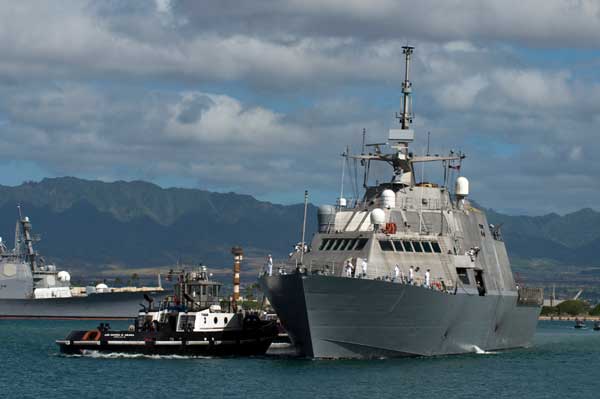A New Capability for the USN-USMC Team
By Robbin Laird and Ed Timperlake
07/12/2011 – The USN is buying the LCS but its Con-Ops remain to be developed. No platform fights alone, and this asset is best understood in terms of the synergy which can be brought to it by how it is connected to other combat systems. The clear partner is the newly configured Amphibious Ready Group or the ARG, built around the F-35B.
These two forces – the LCS and the newly configured ARG – can be conjoined and forged into an enlarged littoral combat capability. But without the newly configured ARG, and the core asset, the F-35B, such potential is undercut.
This is a good example of how buying the right platform – the F-35B – is part of a leveraging strategy whereby greater value is provided for the fleet through the acquisition of that platform.
In a time of fiscal stringency, good value acquisitions need to be prioritized. Such acquisitions are able to leverage already acquired or in the process of being acquired capabilities and provide significant enhancement of capabilities.
They are high value assets, both in terms of warfighting and best value from an overall fleet perspective.
A newly configured USMC ARG is emerging from several new assets:
- The new ARG built around the LPD 17 has a larger deck to operate from, with modern C2 capabilities.
- The F-35B can be launched as a 360 degree presence asset to do electronic warfare, C4ISR and preparation for kinetic or non-kinetic strike.
- The CH-53K can take off from the amphibious ships and carry three times the cargo of a CH-53E, to include 463L pallets (normally used in KC-130s).
- The USMC Ospreys can support insertion operations with speed and range.
What the newly equipped ARG does is provide a significant shaping function for the President. And this shaping function allows significant flexibility, any hard 3000 foot surface is available for the Navy/Marine amphibious forces to seize and hold. This world class uniquely American battle capability is a redefinition of the dichotomy between hard and soft power.
And such capability in turn draws upon the decade of innovation which the USAF has engaged in in shaping the Air Dropping Revolution. As the commander of the Tanker Airlift Control Center (TACC) underscored:
Question: When you put that data out there about air dropping trends, it’s impressive in and of itself, but when you think of the CONOPS implications they are significant as well. I don’t even need to use roads to actually start inserting a force. Interestingly for the Marines when they’re looking at the amphibious ready group (ARG) and what they could do with the future ARG, with their MC-130Js that can land in 3,000 feet or less, the Ospreys and the B’s that they could put basically on almost any paved highway worldwide. They could be anywhere in the world, and then people say, “Well how would you supply them,” and I would say, “Well what do you think we’ve been doing in the last ten years?” So if we marry up this revolutionary air dropping capability with projection of force from the sea, we could have a much more flexible and powerful insertion force if we wanted to.
General Allardice: I agree. Our new air dropping capabilities can be used to support our global operations in new and innovative ways. And honestly, innovation is really the essential takeaway. Through collaboration we are able to optimize the performance of the global mobility enterprise and orient it toward the effect we need. There will always be a tension between capacity and requirements, but we have found a way to manage it that allows us to respond rapidly and address those tensions in ways that would be much more difficult without the processes we have in place.
The USN-USMC amphibious team can provide for a wide-range of options for the President simply by being offshore, with 5th generation aircraft capability on board which provides 360 situational awareness, deep visibility over the air and ground space, and carrying significant capability on board to empower a full spectrum force as needed.
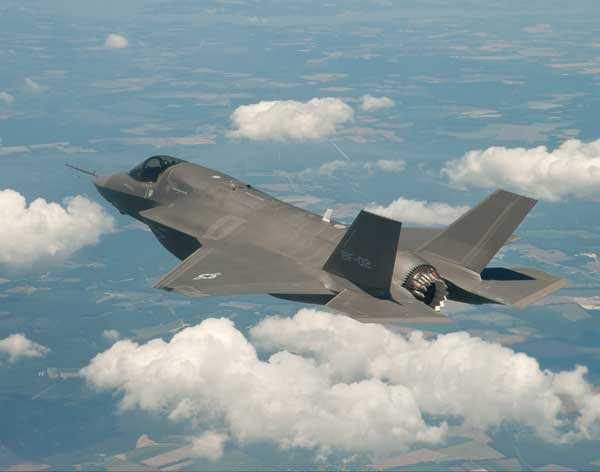 F-35B in Supersonic Flight Test (Credit: Lockheed Martin)
F-35B in Supersonic Flight Test (Credit: Lockheed Martin)
Now add the LCS. The LCS provides a tip of the spear, presence mission capability. The speed of the ship allows it to provide forward presence more rapidly than any other ship in the USN-USMC inventory.
It was said in fighter aviation “speed is life” and in certain situations the LCS can be paid the same complement. The key is not only the ships agility and speed but it can carry helicopters and arrive on station with state-of-the art C4ISR capabilities to meld into the F-35B combat umbrella. Visualize a 40+ knot Iron Dome asset linking to Aegis ships and the ARG air assets.
Inserting an LCS into the Maersk Alabama incident can see an example of the impact of speed. As one naval analyst put it, the impact would have been as follows:
- LCS at 45kts would have been on scene in less than 7 hours (6.7), or 37% sooner than a ship transiting at 28 kts.
- LCS fuel consumption for such a sprint 40% less than the 28 kt sprint.
- LCS would consume less than 23% of her fuel capacity in such a sprint.
- A helo launch within 150 nautical miles from Maersk Alabama puts helo overhead within four hours (4.3) from the time of the initial tasking.
- Two H-60’s permits LCS to maintained a helo overhead Maersk Alabama for a sustained period of time.
- With a response time of four hours the probability of thwarting a piracy attack is increased—especially if the naval ship is called upon the first realization of the targeted ship’s entry into piracy infested waters.
- If an LCS was tasked to respond when Maersk Alabama encountered the first group of pirates craft on 7 April 2009, it would have arrived on scene well in advance of the attack on 8 April and may well have prevented it.
And if you add the LCS to the USN-USMC amphibious team you have even more capability and more options. As a senior USMC MEU commander has put it:
You’re sitting off the coast, pick your country, doesn’t matter, you’re told okay, we’ve got to do some shaping operations, we want to take and put some assets into shore, their going to do some shaping work over here. LCS comes in, very low profile platform. Operating off the shore, inserts these guys in small boats that night. They infill, they go in, their doing their mission.
The LCS now sets up — it’s a gun platform. It’s a resupply, refuel point for my Hueys and Cobras. Now, these guys get in here, okay. High value targets been picked out, there is an F-35 that’s doing some other operations. These guys only came with him and said hey, we have got a high value target, but if we take him out, we will compromise our position. The F-35 goes roger, got it painted, got it seen. This is what you’re seeing, this is what I’m seeing. Okay. Kill the target. The guys on the ground never even know what hit them.
In World War II the Imperial Japanese Navy Admirals were said to call the US PT, or Patrol Torpedo Boats—“Devil Boats”—The LCS is not a PT boat but the LCS ocean presence with 21st Century capabilities may make it a modern “Devil Boat” to vex any enemy combat action.
Similar to the PT boats of WWII the LCS by itself has limited staying power; connected to the ARG, the LCS announces presence and is connected to significant full spectrum combat capability.
Several LCS’s could be deployed with Osprey and F-35B cover. The F-35B provides the 360 degree multiple of hundreds of miles coverage. The LCS becomes a node in the combat system of the F-35 and any weapons on the LCS can be cued up by the F-35B.
With the new aviation assets, the Marine Expeditionary Unit (MEU) can be split at sea allowing it to cover hundreds of miles more than historical operations with unexpended speed and maneuverability.. And adding an LCS to each of the disaggregated elements can further enhance the presence and combat functions of the MEU.
An Osprey pilot has already indicated that Ospreys have already allowed the splitting of the Marine Expeditionary Unit (MEU) at sea.
I saw so much potential for the short take-off vertical landing attack aircraft, fixed-wing aircraft and the V-22 working together. In the future, I would have those two, the V-22 and F-35 working very closely together and even for extended operations when you add the refueling piece. The paring of these two aircraft are far better than paring the V-22 with any of the helicopters.
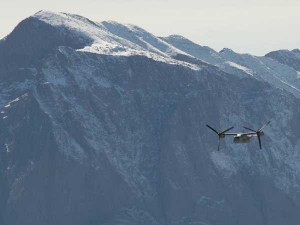
Because of speed, range. And not only that. It’s the endurance of the aircraft itself. Basically you might say once it’s flying, it’s flying. And we had a lot of missions that required flight time above six hours, which is very taxing for the jet guys and for us, it is as well, but maybe not so bad because we can trade off in the cockpit. The fact is that you can have airborne assets, both as a package as well as a trap for sensitive site exploitations, being airborne all at the same time for hours at a time to respond to something that happens in the AOR. It will give you the maximum flexibility for response time down to something like thirty minutes, depending on where it is. And then sanitize the scene from there and then everybody returns home. It’s a capability that I’m not going to say it’s been overlooked but it just hasn’t been utilized like that.
The LCS-ARG team cannot only leverage each other’s capabilities, but can lay the groundwork for a significant robotics revolution. The new maritime capabilities built around robotic vehicles, on the sea, under the sea, and over the sea, can be launched and managed by either LCS’s or LPDs.
As the Prospective Commander of the LPD-24 noted, “We have a lot more space of carrying robotic assets. And can work effectively with the LCS. We can easily work with the LCS, especially with her different mission capabilities. And if she needs to change out mission capabilities, we have the cargo space to fulfill her mission.”
And in an interview with the retired head of NAVAIR, Admiral Dyer now COO of iRobot provided a sense of how this team could work with the robotics revolution:
At iRobot, we have a vision of integrated Unmanned Air Vehicles (UAV’s), Unmanned Ground Vehicles (UAV’s) and Unmanned Underwater Vehicles (UUV’s). A way I like to think about that is to envision a littoral combat ship that shows up off the coast of some bad guy’s country. Let’s take a look at how different that will be compared to the way we do it today:
Let’s consider UUVs, which I think are one of the most exciting developmental areas that are underway. UUV’s are, by the way, the area where autonomy is needed more than anywhere else. Why? Well, while you’ve good radio frequency bandwidth when you’re airborne, you have very little bandwidth when communicating with UUVs. Underwater, you’re limited to acoustic modems for un-tethered operations. An acoustic modem is slower than your first dial-up PC connection to the web. But as you start to introduce more autonomy, you start to tremendously increase the utility of unmanned underwater systems. Autonomy is important for the future of all robots, but critically important for UUVs. That is what iRobot is building at our unmanned underwater systems group in Raleigh-Durham, North Carolina. But let’s continue with this Navy ship showing up with a Navy/Marine Corps team on an adversary’s littoral during the next decade. The preparation for entering that battle space will be tremendously improved in many ways by unmanned systems.
I worry that the Navy has not taken full notice of the IED threat. Our Navy’s interest in and focus on maritime IEDs (mines) is episodic and our attention has always been short. Unmanned systems will offer new capabilities at sea, just as unmanned ground robots have for ground forces.
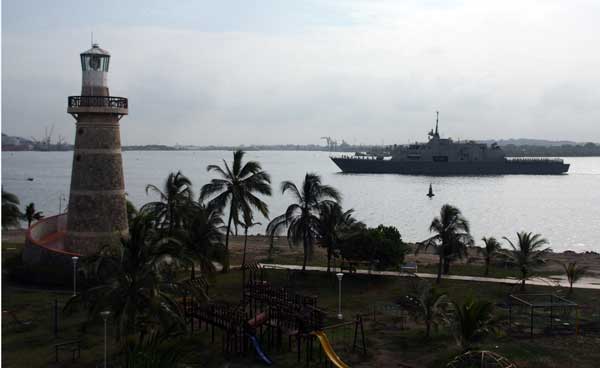 USS Freedom in Transit (Credit: USN)
USS Freedom in Transit (Credit: USN)
When asked how one would deliver such capabilities into the battlespace, the airborne assets of the LCS and the ARG were highlighted:
I believe UUV’s offer great potential but there are challenges. The prime challenges for UUVs are range and power,area coverage. UUVs have the disadvantages of being relatively slow and of limited search duration. So you can’t efficiently transit them; you have to deliver them to the area of interest. At iRobot, we’re coming at this problem with our Ranger program, which we’re funding atop some basic work sponsored by the Office of Naval Research. We are designing a Ranger UUV that’s “A-size.” “A-size” means it fits into a sonobouy launcher. And there are literally thousands of tubes out there on multiple patrol and tacair platforms. Marry the capability to air-launch with swarm capability and you cut out the transit time, greatly reduce the power requirement and introduce UUVs directly into the area of interest.
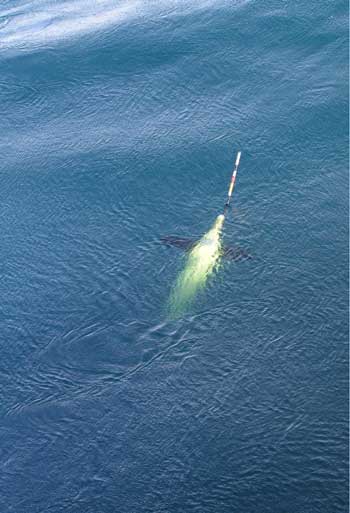
Using swarm techniques, which DARPA has funded iRobot and others to develop; you start to see the operations research numbers get much, much better. This isn’t something that’s awaiting better batteries and more power; it’s awaiting further development of a new concept.
No platform fights alone, but often when the LCS gets discussed it is discussed only alone, but it has very little staying power in and of itself, as has been clearly noted by a senior USN Admiral in discussing the approach to LCS sustainment.
Question: The LCS is really a collaborative ship, so you’re doing collaborative con-ops and the sustainment approach is part of those collaborative con-ops. It seems that what is crucial for a new built platform, whether it be air or whatever, is that you’re doing in terms of maintenance from the initial shaping of the con-ops. So presumably the relationship of the LCS to other ships is a key part of the distance support and not just to the shore.
Admiral McManamon: Part of what the exploration is doing is shaping the build as we get new information from the maintenance efforts. For the initial deployment for USS Freedom, much of what we are doing is ringing out the basic mechanics, the engineers, being able to put the ship in the water, being able to communicate with other ships, being able to talk to an operator or air assets, etx : all this has been extremely successful from February to the end of April this first year. And from this deployment we start to shape standards of performance. She was able to do the connectivity essential to distance support; she was able to operate in ways that took advantage of a 2,800 ton ship going 40 plus knots. As one of our commanders indicated just last week, there’s this whole psychological power to itself for a 2,800 ton ship to go after a go-fast and actually be able to sustain in, keep up and take it down, which we simply can’t do in the current environment with regular navy ships.
But did I design and build LCS simply to run after a cigarette runner? No. But does it give me that capability when I need it? Yes, and as we now understand that capability and that connectivity necessary to do the con-ops, I think that’s exactly what we’re moving forward with to shape future ships and operations.
And the glue which generates LCS-ARG synergy are the aviation assets on the two entities, notably the Osprey and F-35B which have the speed and range to create a moving 360 degree combat and presence bubble over an operation. Without that glue, these platforms become disaggregated and vulnerable. Linked together, the resulting synergy creates a force multiplier effect.
And such a multiplier effect can have a significant deterrent effect. General “Dog” Davis, the Commander of the 2nd Marine Aircraft Wing at Cherry Point, North Carolina, underscored such an impact when discussing the newly enabled ARG.
I’m Muammar Gaddafi. I’m whoever, and I’ve got an ARG with this new gear embarked – and I can’t help but think its going to change the way I view that force. That ARG can reach out and touch me from long range, landing high-end infantry forces deep inside my territory, and do so with a speed that twice as fast as anyone else can. Our MEUs have never been used as effectively as they are today. These new capabilities are going to make them exponentially more potent and useful to our nation’s leadership.
The F-35Bs give the new ARG a very high-end air superiority fighter, that’s low observable if I want it to be. I can roll from Air to Air to Air to Ground quickly and be superior to all comers in both missions. That’s bad news for our adversaries. I can use the F-35s to escort the V-22s deep into enemy territory. With those V-22s we can range out to a 400-500-mile radius from the ship without air refueling. I can go deliver Marines deep in the enemy territory or wherever and do it at 250 miles an hour, so my speed of action, my agility is exponentially increased, and I think if you’re a bad guy, that would probably give you a reason to pause. It’s a very different animal that’s out there. We are good now, but will be even more so (by more than a factor of two in the future).
I also have significant mix and match capability. And this capability can change the impact of the ARG on the evolving situation. It is a forcing function enabled by variant mixes of capability. If I wanted to strip some V-22s off the deck, to accommodate more F-35s – I could do so easily. Their long legs allow them to lily pad for a limited period of time — off a much large array of shore FOBs – while still supporting the MEU. It’s much easier to do that in a V-22 than it is a traditional helicopter.
I open up that flight deck, or I can TRANSLANT or PAC additional F-35s. If I had six on the deck and I want to fly over another six or another four, we could do it rather quickly. Now the MEU has ten strike platforms. So if I need to have a TACAIR surge for a period of time, that deck provides a great platform for us. We’ve got the maintenance onboard that ship, so we can actually turn that Amphib very quickly from being a heliocentric Amphib to a fast jet Amphib. Conversely, I could also take the F-35s off, send them to a FOB and load it up with V-22s, 53Ks, or AH-1Zs and UH-1Ys.
Flexible machines and flexible ships. The combination is exceptional.
We will have a very configurable, agile ship to reconfigure almost on a dime based on the situation at hand. I think the enemy would look at the ARG as something completely different from what we have now. I think we have to change the way we do things a bit in order to allow for that, but I think we will once we get the new air assets. The newly enabled ARG, or newly whichever the term you’re using, will force our opponents to look at things very differently. We will use it differently, and our opponents are going to look at it differently.
Finally, being connected to the newly enabled ARG can intelligently facilitate LCS modernization. The LCS can carry a range of assets, from missiles, to helos, to unmanned assets, to a complement of distributed “cyber warriors” all of which can much more potency by being part of the ARG team. The F-35B can perform the function of the battle manager, without the presence of large USAF aircraft, or a carrier presence. This is truly a combat revolution in the making.


